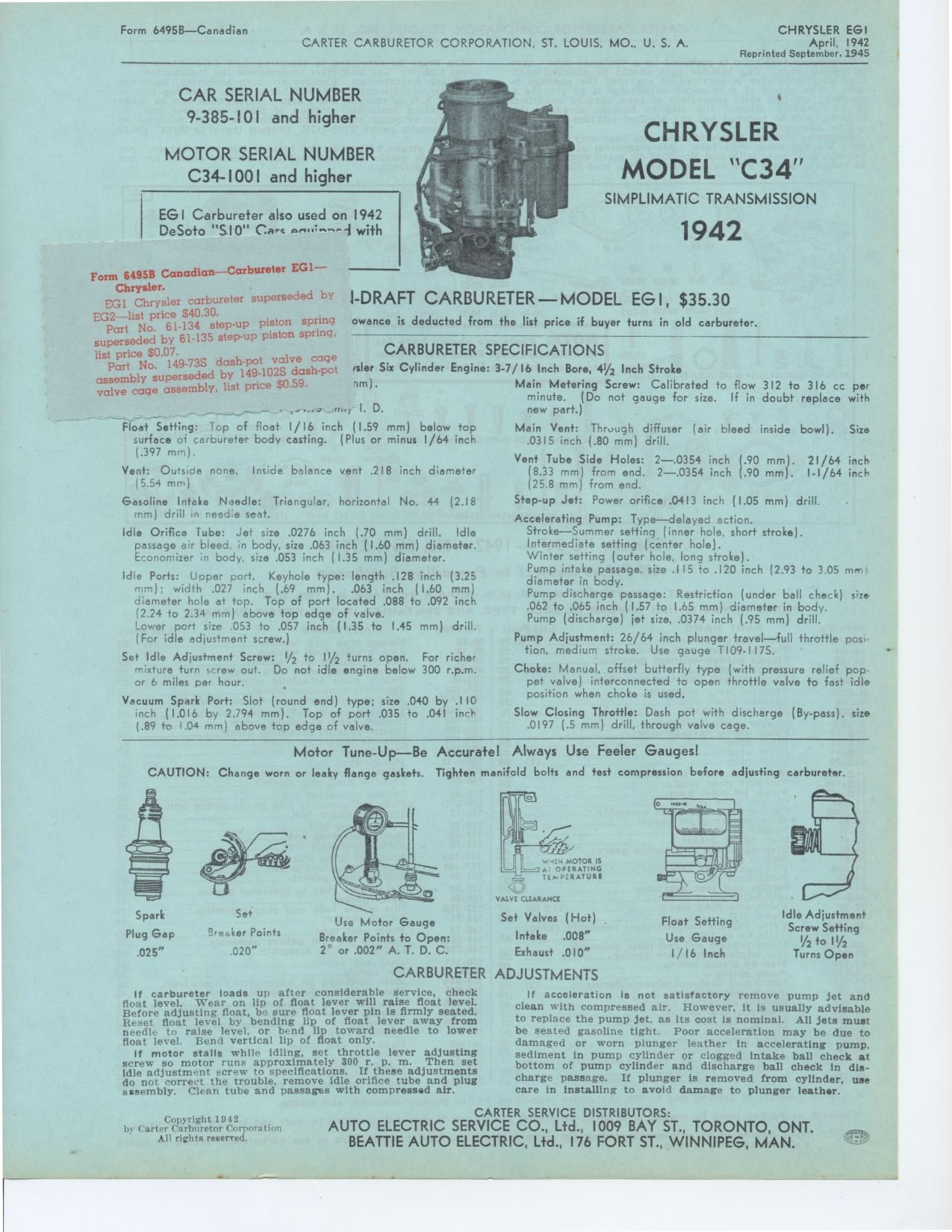Chrysler Old Carter Carburetors : CHRYSLER MODEL "C34 SIMPLIMATIC TRANSMISSION 1942Previous | Home | Next |
 |
Form 6495B—Canadian
CHRYSLER EGI
April, 1942
Reprinted September, 1945
CHRYSLER MODEL "C34
SIMPLIMATIC TRANSMISSION 1942
EGI Carbureter also used on 1942 DeSoto "SI0" Caere onrr:—e-ii
with
1-DRAFT CARBURETER—MODEL EG I, $35.30
owance is deducted from the list price if buyer turns in old carbureter.
CARBURETER SPECIFICATIONS
rsler Six Cylinder Engine: 3-7/ 16 Inch Bore, 41/2 Inch Stroke
Main Metering Screw: Calibrated to flow 312 to 316 cc per minute. (Do not gauge
for size. If in doubt replace with new part.)
Main Vent: Through diffuser (air bleed inside bowl). Size
.0315 inch (.80 mm) drill.
Vent Tube Side Holes: 2—.0354 inch (.90 mm). 21/64 inch (8.33 mm) from
end. 2—.0354 inch (.90 mm). I-I/64 inch (25.8 mm) from end.
Step-up Jet: Power orifice .0413 inch (1.05 mm) drill.
Accelerating Pump: Type—delayed action.
Stroke—Summer setting (inner hole, short stroke). Intermediate setting
(center hole).
Winter setting (outer hole, long stroke).
Pump intake passage, size .115 to .120 inch (2.93 to 3.05 mm: diameter in body.
Pump discharge passage: Restriction (under ball check) size. .062 to .065 inch
(1.57 to 1.65 mm) diameter in body. Pump (discharge) jet size, .0374 inch (.95
mm) drill.
Pump Adjustment: 26/64 inch plunger travel—full throttle position, medium
stroke. Use gauge T109-117S.
Choke: Manual, offset butterfly type (with pressure relief pop-pet valve) interconnected
to open throttle valve to fast idle position when choke is used.
Slow Closing Throttle: Dash pot with discharge (By-pass), size .0197 (.5 mm)
drill, through valve cage.
Motor Tune-Up—Be Accurate! Always Use Feeler Gauges!
CAUTION: Change worn or leaky flange gaskets. Tighten manifold bolts and test
compression before adjusting carbureter.
Form 6495B Canadian—Carbureter EG1
Chrysler.
EG1 Chrysler carbureter superseded by
EG2--list price $40.30. piston spring
Part No. 61-134 step-up p spring,
superseded by 61-135 step-up piston
list price $0.07.
Part No. 149-73S dash-pot valve cage
assembly superseded by t 149-102S price $0 dash pot nm). valve cage assembly,
MOTOR SERIAL NUMBER
C34-100I and higher
CAR SERIAL NUMBER 9-385-10I and higher
1942
ff
Float Setting: Top of float 1/16 inch (1.59 mm) below top surface of carbureter
body casting. (Plus or minus 1/64 inch (.397 mm).
Vent: Outside none. Inside balance vent .218 inch diameter (5.54 mm)
Gasoline Intake Needle: Triangular, horizontal No. 44 (2.18 mm) drill in needie
seat.
Idle Orifice Tube: Jet size .0276 inch (.70 mm) drill. Idle passage air bleed,
in body, size .063 inch (1.60 mm) diameter. Economizer in body, size .053 inch
(1.35 mm) diameter.
Idle Ports: Upper port. Keyhole type: length .128 inch (3.25 mm); width .027
inch (.69 mm). .063 inch (1.60 mm) diameter hole at top. Top of port located
.088 to .092 inch (2.24 to 2.34 mm) above top edge of valve.
Lower port size .053 to .057 inch (1.35 to 1.45 mm) drill. (For idle adjustment
screw.)
Se+ Idle Adjustment Screw: I/2 to 11/2 turns open. For richer mixture turn
screw out. Do not idle engine below 300 r.p.m. or 6 miles per hour.
Vacuum Spark Port: Slot (round end) type; size .040 by .110 inch (1.016 by
2.794 mm). Top of port .035 to .041 inch (.89 to 1.04 mm) above top edge of
valve.
Use Motor Gauge
Breaker Points to Open:
2° or .002" A. T. D. C.
'-ACV MOTOR IS A; OPERATING TENiP:RATURE
VALVE CLEARANCE
Set Valves (Hot) Intake .00B" Exhaust .010"
Float Setting Use Gauge 1/16 Inch
Idle Adjustment
Screw Setting
1/2 to I V2
Turns Open
Spark Plug Gap .025"
Se+
°reaker Points
.020"
CARBURETER ADJUSTMENTS
If carbureter loads up after considerable service, check float level. Wear
on lip of float lever will raise float level. Before adjusting float, be sure
float lever pin is firmly seated. Reset float level by bending lip of float
lever away from needle to raise level, or bend lip toward needle to lower float
level. Bend vertical lip of float only.
If motor stalls while idling, set throttle lever adjusting screw so motor runs
approximately 300 r. p. m. Then set Idle adjustment screw to specifications.
If these adjustments do not correct the trouble, remove idle orifice tube and
plug assembly. Clean tube and passages with compressed air.
If acceleration Is not satisfactory remove pump jet and clean with compressed
air. However, it is usually advisable to replace the pump jet, as its cost
is nominal. All jets must be seated gasoline tight. Poor acceleration may be
due to damaged or worn plunger leather in accelerating pump, sediment in pump
cylinder or clogged intake ball check at bottom of pump cylinder and discharge
ball check in discharge passage. If plunger is removed from cylinder, use care
in installing to avoid damage to plunger leather.
Copyright 1942